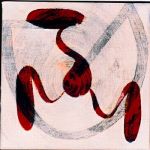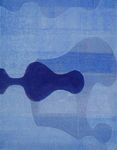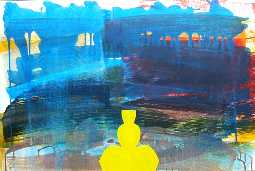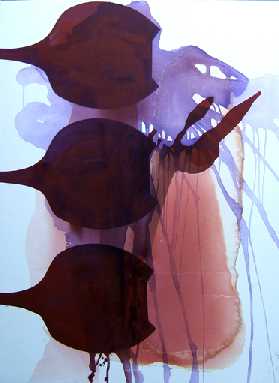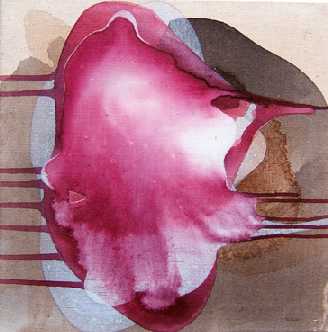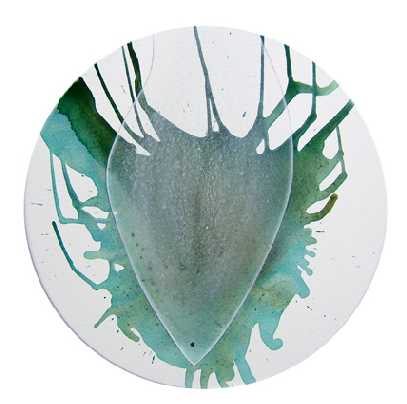Vincent van Oss shapes spaces
exposition in Artistik galerie, Amsterdam
A forward-looking trend is slowly but surely becoming apparent within the abstract art of recent years. However, it has nothing to do with a radical break based on a manifesto; it is driven by individual artists, each of whom reinvents the wheel independently because they apparently cannot avoid doing this. This new trend is occurring in figurative as well as abstract art. Modern openness and new forms of transparency are appearing in both these domains. These characteristics are often accompanied by a greater complexity, which seems to arise spontaneously as soon as multiple layers are employed in a work of art.
There is a cast-iron rule in the world of modern art: if artists want to represent their contemporary experiences then they are compelled to develop a new visual idiom; it is impossible to revert to the existing stock. Other sources have to be found and these often already exist in the everyday world around us. It is no coincidence that we have been seeing and experiencing an increasing transparency in our everyday lives over the last 15 years: in glass bus shelters or the openwork supporting structures of stations and shopping malls, and in the complex reflections in illuminated display windows of the city at night. The simple introduction of double glazing in our homes and offices has radically altered the way we look at and perceive things, because of the complex echoes they generate. At night, in the dark windows of the train, we see ourselves reflected kaleidoscopically, because multiple backgrounds jostle and merge in the reflective glass; it results in a mirror image with a deceptive stratification.
Vincent van Oss is an artist who is consciously developing a new visual idiom. Because he positions himself within the tradition of abstract art, he has set himself the task of restructuring or radically replacing the existing visual idioms within this domain. The selection of his works presented during a 2006 exhibition at the Artistik gallery in Amsterdam made it easy to follow this process. The exhibition represented five years of his development, both in the visual idiom Van Oss employs and the various spatial qualities that have gradually evolved in his paintings.
It is no mere coincidence that Vincent van Oss has ended up working in the world of abstract art. During his studies at the St. Joost Academy of Art and Design in Den Bosch his tutors included Ger Lataster and Lei Molin. Both these painters are leading representatives of post-war abstract painting in the Netherlands. A shared feature of the work of these two artists is the high degree of openness, a quality that has become increasingly dominant in the compositional structure of the abstract paintings by Vincent van Oss.
In his earliest works, from 1989 on, Vincent van Oss already put the closed, two-dimensional surface into perspective to a certain extent: the background of the painting is built up from stylized forms in thin layers of paint. The linen and the underlying layers of paint remain clearly visible, so that one’s gaze into the depths of the painting is not completely obstructed. During this phase, chance and confrontation were elicited by positioning concisely ‘cut-out’ objects or figures from a completely different world in front of the background with a certain arbitrariness. These sharply defined, stylized figures were created with the aid of stencils and are therefore pre-fabricated. They float or hang suspended in the foreground and forcibly open up the deeper reaches of the painting. We are forced to look beyond these figures, since our gaze glides off on their flat silhouette and finds no other visual anchor. They resemble something that has been manufactured and possess a formal visual idiom; they barely establish a relationship with the background. Because of their provocative and incongruous presence within the big, empty field of the painting, they conjure up associations with Dada and the work of Hans Arp. They hover, structuring the space in nothing more than a rudimentary manner. As viewers we are obliged to bridge the great distance they evoke with respect to the rest of the painting for ourselves. There lies the challenge they present.
Vincent van Oss has been cutting out his stencils since his time as an art student. He has, moreover, carefully preserved them, and now they are being redeployed as tools for the creation of the pre-fabricated figures. The resulting visual idiom is uncomplicated and pared down, displaying a close affinity with hard-edged, modern design and cartoon animations. Van Oss calls them ‘Barbapapa and Barbamama’, the characters from a series of children’s books that was adapted for television and broadcast in the 1970s. These fairly plump, stylized figures could morph at will, just like an octopus, into any form imaginable, according to the demands of the narrative. Van Oss’s prefab figures are also nothing more complex than silhouettes superimposed on his canvases. The outlines are spherical or concave, sometimes combined with a rectangular outline or a sharply demarcated angle. They are reminiscent of chess pieces or the ‘Pacman’ icons from the earliest generation of computer games.
This formal visual idiom marks the introduction of a fundamental, consciously introduced dichotomy in the paintings from this period. The distinct figures in the foreground function merely as a reference point, as a purchase that makes it possible for the eye to peer into the depth it conjures up. There is an abundance of empty space suspended between foreground and background; hardly any structured space remains. As an onlooker you are expected to jump into the resulting void in order to imagine the rest of the painting without signposting, or you might simply pass by because you require more assistance in order to enter into communication. These early canvases clearly illustrate the challenging yet elemental genesis of the abstract paintings by Vincent van Oss, from which his later work could evolve.
Fig. 3: Untitled, acrylic on canvas, 70 x 105 cm, 2001
From 2001, the backgrounds in paintings by Van Oss start to change considerably, the rearmost layers being realized much more intuitively – they develop with a light, quasi-nonchalant touch of paint. This also renders them more complex, because the rigid stylization disappears and several layers of paint emerge there, visibly overlapping. Despite this shift, very few tangible spaces remain in the painting. The pregnant dichotomy of this visual idiom – the sharply defined figures to the fore and the sweepingly realized background – is retained as before. However, the figures are now small, clear-cut outlines, ‘little things’ that we see floating across the canvas, like insects against a window pane.
Now, moreover, the chance aspect is deliberately elicited, brought into the process of the work’s creation. This step was achieved by pouring the paint onto horizontal canvases and allowing it to spread out randomly by tilting the painting here and there. Van Oss then leaves the paint to dry in that horizontal position, which has a tangible impact on the paintings because the structure of the linen becomes more prominent. This pouring technique results in a complex stratification; the various fields of colour that have flown across each other remain visible because they do not obscure one another. Opting for this methodology seems to me like a deliberate and progressive choice! We now see the evolution of layer upon layer upon layer, guided by the tilting of the canvas. Along with the resulting transparency we see a greater three-dimensionality and complexity in the painting’s compositional structure. Pouring paint soon became a more trusted technique than the paint brush for Van Oss. He has been using this technique – initially intended to elicit intuition and aleatoric outcomes – in a deliberate and strategic manner since 2003.
Fig. 4: Untitled, acrylic on canvas, 180 x 135 cm, 2002)
The summers of 2002 and 2003 saw the production of a series of large paintings on which the applied stencil figures – now in sizeable formats – started to merge with the thinly spread fields of paint. They no longer float intangibly across the canvas, but evolve from freestanding figures into a vigorous flat shape. They thus become a structural and dynamic component of the painting that enters into and evinces interrelationships: they synthesize. One can perceive a close kinship with the German abstract painter Ernst Wilhelm Nay, who in 1960 or thereabouts intentionally chose his hallmark disc as the basic form for the ‘supporting’ layers within the painting. With both painters it is possible to see the painting as a constellation of robust, two-dimensional forms that partially overlap, interrupt or repulse one another. The large shapes are palpably active in the structuring and subdivision of space and depth in the painting. This establishes a decisive conceptual distance from the dogma of the flat surface of early abstract art, by which any suggestion of depth was painstakingly eliminated. Vincent van Oss would from now on employ several large shapes, which promulgate the requisite architecture of the painting solely in relation to one another. They jointly differentiate the depth, even though they themselves remain fairly flat, because our eyes still collide with their surface.
These shapes acquire their structuring force because Van Oss’s large figures return repeatedly in a perceptible rhythm within a single painting or he sets them alongside one another in a dynamic ensemble of form and counter-form. This marked a significant shift in his work, since it generates energy, introducing dynamism in the painting. The large, formalistic prefab shapes join battle with the ‘aleatoric’ forms that arise from pouring the paint. The same two forces are at work as before, but while in his earlier canvases they glide past each other unaffected, now they can no longer avoid each other. In these collisions they are reasonably equal in power and volume, so neither of them emerges from the struggle untouched. The prefab figures can no longer maintain their typical stylization wholly intact, because they are affected by or integrated into the flowing fields of paint. In turn, the free path of the poured paint is restricted by the strong outlines produced by the stencils, by the intermingling of soft and hard, which results in the emergence of a different atmosphere in the work. The difference in the appearance and genesis of these two visual idioms thus produces a sumptuous mix. It leads to mysterious structures, which are sometimes more pronounced and at other times almost embryonic and diffuse. This battle of strength also invokes the intuitive aspect of painting, because the outcomes of the skirmishes are not wholly predictable. In the definitive version of the canvases this remains tangibly present, because the traces of chance have not been ‘painted out’. Two large canvases (figs. 4 and 5) illustrate this phase in Vincent van Oss’s painting, with large forms gliding in front of or behind each other. While looking we are forced to float wholly independently; there is no longer the visual anchor of a sharply outlined pawn or Pacman hovering in the foreground.
fig. 5: Untitled, acrylic on canvas, 180 x 135 cm, 2004
The last two years are a period in which Van Oss has worked exclusively in small formats, producing series of small paintings in rectangular as well as circular forms. It seems like a period of consolidation, the paintings revealing clear-cut conclusions have been drawn on the basis of what preceded. There is a great deal of controlled complexity. In this series of small canvases, the previously evident stark dichotomy within the painting has been resolved. The background no longer remains in its familiar position to the rear, but has ended up floating and in some places pushes itself to the fore in the painting. This results in all kinds of different depths and hollows. Even the two-dimensional, stencil-like figures that were previously flat are now folded or remodelled. They become three-dimensional sculptures into which we can penetrate with our eyes. This moulds the space of the painting in a complex manner, subdividing it into all kinds of chambers and rooms. The consciously produced folds and hollows result in a visual idiom with distinctly organic forms. They are, moreover, enigmatic, because when peering at them it is rarely evident into what kinds of spaces we are shifting. The perspectives are highly diverse. We have to negotiate bends with our eyes and manoeuvre skilfully in order to be able to peer behind an obstructive sphere or to penetrate deeper through a narrow slot. Sometimes there is nothing but the suggestion of a vague, embryonic existence.
Fig. 6, Untitled, acrylic on canvas, 40 x 40 cm, 2004
The key in modern art is to remain clear-headed in the face of great complexity and inscrutability, and in my opinion Vincent van Oss succeeds in this. The stencilled figures with their distinctive outlines contribute to this, once they have been integrated into the painting as a whole. Van Oss also seems to engineer that clarity by pursuing a high degree of abstraction and very deliberately structuring his paintings, thus permitting hardly any leeway for chance or intuition. That is not always necessary, because both chance and intuition have been amassed over the preceding years; a virtual stockpile has been amassed. But this also makes one wonder when the stockpile will be depleted. Abstraction is, after all, a process of purging, of exculpation, and before you know it all that remains is the abstraction itself; one’s intuition has gone in search of a new niche. A few of the recent circular paintings by Vincent van Oss leave me with the impression that the process of intensive abstraction results in de-cluttering; the canvases become somewhat rarefied. Time will tell. This is, moreover, an unavoidable risk, and one which must be faced, because painting is motion! Painting is also inspired, and the time to pluck the fruit is not decided by the artist; he merely recognizes the ideal moment.
The severe stencilled figures of the earlier work seem to have been completely absorded into the moulded space; they end up being completely unified. This inevitably represents a gain as much as a loss. Their previously unamenable, provocative personality no longer refreshes the painting and no longer establishes the provocative distance that can prompt us to look. On the other hand, this integration results in quasi-traditional abstract paintings with a deeper sonority in form and palette. This certainly does not imply that they close themselves off, because their architecture remains open and accessible to our gaze. It is more a case of there being an analogous wavelength shrouding the whole canvas, because the sharply incisive outlines of the stencil-like figures have completely disappeared. They have dissolved into a predominantly organic visual idiom. The resulting spatial sculptures are certainly inscrutable, raising the question of what kind of world we actually end up in while we are looking. When I contemplate these canvases, they often conjure up associations with television images of keyhole surgery, the camera entering the body like a curious extension of our eyes. I also see an affinity with the landscapes from the sci-fi film The Matrix, in which the deliquescence of situation and image is a typical feature, so that our everyday spatial orientations become disoriented in order to render us more receptive.
A number of recent small paintings by Vincent van Oss demonstrate a perfect balance between melting evocation and the preservation of a clear-cut structure, which is necessary in order to imbue the architecture of the painting with its resilience. I predict this is a temporary equilibrium, because it is founded on preceding developments. It undoubtedly has its limitations, so it is best to fully exploit this period: the fruits must be picked now. Successful integration only works for the full 100 percent. No unprocessed scraps with which one might move forward, remnants as nourishment for the following canvas, are left behind in the work. In that sense, integration in art is voracious: all the stored-up intuition is completely exhausted.
Fig. 7, Untitled, acrylic on canvas, 50 cm in diameter, 2005
In the most of the recent paintings by Vincent van Oss we look at vivid visual scenes. They communicate forms of reality that do not exist yet. They turn potential spaces into a visual idiom, but as soon as this visual idiom starts to lead a convincing existence of its own then these spaces also become real – that is the magic of painting. This results in fantastical landscapes, as depicted by Joos de Momper and Hercules Segers some 400 years earlier. Indeed, in the work of Van Oss one sees the conscious propagation of a fantasy about realities that do not yet exist. The paintings represent suspicions about spaces where our everyday references points no longer suffice. But do our eyes really want to enter those spaces? Are we prepared to travel through them, despite the high degree of unpredictability? Then we must be able to navigate and manoeuvre based on our intuition, as during the spectacular flight of the spaceship in The Matrix III.¹ What kind of contribution do these canvases make? How do they function socially? I have become increasingly convinced that over the coming 50 years we will desperately need our spatial fantasy in order to survive mentally and in order to be able to shape the future.
The paintings of Vincent van Oss are aesthetically sensitive, virtual exercises in manipulating space, in our thoughts and fantasies as well as in our emotional experiences. They give us flying lessons, as it were, in hovering, zooming in and out, abandoning boundaries, daring to rely on suspicions and intuition, opening paths to new knowledge and conjecture. Nevertheless, most of his paintings remain lucid and sound in their construction: they are honest. They are also attractive, sometimes even seductive.
We will have to face with many unknowns over the coming decades. Many recent discoveries are at the point of being applied in practice: genetic manipulation, the practical applications of nanotechnology. We are also seeing the emergence of far-reaching insights, as in cosmology, with its latest discoveries concerning our universe and its suspicions about parallel universes. We will have to learn how to survive mentally in a world of boundless possibilities, because the future is revealing itself more and more keenly and intensely, and the feasibilities and variations of life forms are only increasing. We humans will soon be living longer and therefore experience more of the future in the space of a single lifetime. Our children will easily attain 150 years of age, perhaps more. Everyone will have to find a role in life in the midst of these changes, because every human being is an active and valuable component in future developments.
Visual representations of three-dimensional space and all kinds of apertures into dimensions and realities as yet unknown are essential in order to provide us with new and transparent frameworks of reference. Sixty years after it arose, the old abstract art has become rooted in the design of the road signs that now control our everyday lives. Transparent paintings such as those by Vincent van Oss will boost our wherewithal to cope mentally and to nurture our fantasy for a future that is wholly unpredictable, an open book.
29 December 2005
Fons Heijnsbroek

